The Aesthetic Value of World Heritage Karst: A Literature Review and Implication for Huangguoshu Scenic Area Outstanding Universal Value
Abstract
1. Introduction
2. Data Collection
3. An Overview of the Aesthetic Value of World Heritage Karst
3.1. Annual Distribution of the Literature
3.2. Content Distribution of the Literature
3.3. Country Distribution of the Literature
3.4. Themes and Topics
4. Main Progress and Landmark Achievements
4.1. Theoretical Research
4.2. Evaluation Methods
4.3. Aesthetic Importance and Natural Beauty
4.4. Protection and Development of Karst Landscape
5. Discussion
6. Conclusions and Future Research
Author Contributions
Funding
Institutional Review Board Statement
Informed Consent Statement
Data Availability Statement
Conflicts of Interest
References
- UNESCO WHC. What Is World Heritage? Available online: https://whc.unesco.org/en/faq/19 (accessed on 23 November 2022).
- Dudley, N. IUCN: An Application Guide for Management Classification of Nature Reserves; China Forestry Publishing House: Beijing, China, 2016; p. 4. [Google Scholar]
- UNESCO. Operational Guidelines for the Implementation of the World Heritage Convention. 2019. Available online: https://whc.unesco.org/en/guidelines (accessed on 29 November 2022).
- UNESCO. Convention Concerning the Protection of the World Cultural and Natural Heritage. 1972. Available online: https://whc.unesco.org/en/convention/ (accessed on 29 November 2022).
- Brandolini, P.; Faccini, F.; Robbiano, A.; Bulgarelli, F. Geomorphology and cultural heritage of the Ponci Valley (Finalese karstic area, Ligurian Alps). Geogr. Fis. Din. Quat. 2011, 34, 65–74. [Google Scholar]
- Guerra, V.; Lazzari, M. Geomorphological mapping as a tool for geoheritage inventory and geotourism promotion: A case study from the middle valley of the Marecchia river (northern Italy). Geomorfol. Relief. Process. Environ. 2021, 27, 127–145. [Google Scholar] [CrossRef]
- IUCN. Study on the Application of Criterion VII: Considering Superlative Natural Phenomena and Exceptional Natural Beauty within the World Heritage Convention [EB/OL]. 2013. Available online: https://portals.iucn.org/library/node/10424 (accessed on 29 November 2022).
- Coratza, P.; Hobléa, F. The Specificities of Geomorphological Heritage. In Geoheritage; Elsevier: Amsterdam, The Netherlands, 2018; pp. 87–106. [Google Scholar] [CrossRef]
- Cidell, J. Content Clouds as Exploratory Qualitative Data Analysis. Area 2010, 42, 514–523. [Google Scholar] [CrossRef]
- Cui, W.; Wu, Y.; Liu, S.; Wei, F.; Zhou, M.X.; Qu, H. Context-Preserving, Dynamic Word Cloud Visualization. IEEE Comput. Graph. Appl. 2010, 30, 42–53. [Google Scholar] [CrossRef]
- Robert, E.D. Founder of Modern Geography; The Commercial Press: Beijing, China, 1980; p. 30. (In Chinese) [Google Scholar]
- Naveh, Z.; Lieberman, A.S. landscape Ecology, Theory and Application; Springer: Berlin/Heidelberg, Germany, 1984. [Google Scholar]
- Sochava, V.B.; Yang, H. Principles of physical geographic zoning. Prog. Geogr. 1958, 2, 111–117. [Google Scholar]
- Council of Europe. Europe Landscape Convention; Council of Europe: Strasbourg, France, 2000. [Google Scholar]
- Yuan, D.X. Chinese Karst Science; Geological Publishing House: Beijing, China, 1994. [Google Scholar]
- Liu, H.Y.; Cheng, D.P.; Ye, Y. Study on the Classification and Evaluation of Karst Landscape in Guilin. J. Guangxi Norm. Coll. 2006, 23, 12–17. [Google Scholar]
- Chen, A.Z. On the Classification of Sand (Conglomerate) Landform Types and Their Place and Role in Tourism. Land Resour. Her. 2004, 1, 11–16. [Google Scholar]
- UNESCO WHC. Nomination File 1248bis. 2014. Available online: https://whc.unesco.org/en/list/1248/documents/ (accessed on 29 November 2022).
- Du, F.J.; Xiong, K.N.; Xian, Q.P. The Aesthetic Importance and Comparison of Chishui-Xishui Danxia Landscape. J. Guizhou Norm. Univ. 2008, 1, 26–29. [Google Scholar]
- Hu, W.Y. Study on Landscape Pattern and Stability of Hani Terrace in Yuanyang. Master’s Dissertation, Kunming University of Science and Technology, Kunming, China, 2009. Available online: https://kns.cnki.net/KCMS/detail/detail.aspx?dbname=CDFD0911&filename=1011057490.nh (accessed on 29 November 2022).
- Liu, C.L. Global Comparison and Protection and Development Suggestions of Shilin Karst in Yunnan. J. Zhejiang Agric. Sci. 2017, 3, 403–406+411. [Google Scholar] [CrossRef]
- Zhang, B.K. Research on the Integral Conservation and Exhibition of Clif Inscriptions with Settings in the Taishan Mountain, World Heritage Site. Master’s Dissertation, Tsinghua University, Beijing, China, 2016. [Google Scholar]
- He, D.J. Study on the Dynamic of Landscape Pattern and Its Environmental Analysis in the Wuyishan Scenery District. Doctor Dissertation, Northeast Forestry University, Haerbin, China, 2004. [Google Scholar]
- Xie, N.G.; Zheng, X.Z.; Gu, G.C. Study on the Aesthetic Value Evaluation of Stone Forest Landscape in Yunnan. Geogr. Res. 2001, 5, 517–526. [Google Scholar] [CrossRef]
- Jiao, Y.M.; Yang, Y.Y.; Hu, W.Y.; Su, S.H. Analysis of the Landscape Pattern and Aesthetic Characteristics of the Hani Terraced Felds. Geogr. Res. 2006, 4, 624–632. [Google Scholar]
- Mirghaed, F.A.; Mohammadzadeh, M.; Salmanmahiny, A.; Mirkarimi, S.H. Assessing the Interactions between Landscape Aesthetic Quality and Spatial Indices in Gharasoo Watershed, North of Iran. Int. J. Environ. Sci. Technol. 2020, 17, 231–242. [Google Scholar] [CrossRef]
- Xiao, S.Z.; Xiao, H.; Wu, Y.H. Assessment of the Construction Project on the Aesthetic Values of World Heritage Landscape Based on GIS Viewshed Analysis: A Case Study of Wulingyuan World Natural Heritage Site. Guilin Univ. Technol. 2020, 40, 516–522. [Google Scholar]
- Long, P.T.; Perdue, R.R.; Allen, L. Rural Resident Tourism Perceptions and Attitudes by Community Level of Tourism. J. Travel Res. 1990, 28, 3–9. [Google Scholar] [CrossRef]
- Turner, R.K.; Paavola, J.; Cooper, P.; Farber, S.; Georgiou, S. Valuing Nature: Lessons Learned and Future Research Directions. Ecol. Econ. 2003, 46, 493–510. [Google Scholar] [CrossRef]
- Holdren, J.P.; Ehrlich, P.R. Human Population and the Global Environment. Am. Sci. 1974, 62, 282. [Google Scholar]
- Zhao, H.C.; Xu, S.B.; He, J.S. Analytic Hierarchy Process; Science Press: Beijing, China, 1986. [Google Scholar]
- Opschoor, J.B. The Value of Ecosystem Services: Whose Values? Ecol. Econ. 1998, 25, 41–43. [Google Scholar] [CrossRef]
- Costanza, R.; D’Arge, R.; Groot, R.D.; Farber, S.; Grasso, M.; Hannon, B.; Limburg, K.; Naeem, S.; O’Neill, R.V.; Paruelo, J.; et al. The Value of the World’s Ecosystem Services and Natural Capital. Ecol. Econ. 1997, 25, 3–15. [Google Scholar] [CrossRef]
- Heal, G. Valuing Ecosystem Services. Ecosystems 2000, 3, 24–30. [Google Scholar] [CrossRef]
- Costanza, R. Social Goals and the Valuation of Natural Capital. Environ. Monit. Assess. 2003, 86, 19. [Google Scholar] [CrossRef]
- Howarth, R.B.; Farber, S. Accounting for the Value of Ecosystem Services. Ecol. Econ. 2002, 41, 421–429. [Google Scholar] [CrossRef]
- Chen, W.H.; Zhu, X.W.; Zhu, D.H.; Huang, B.J. Karst Landscape Characteristics and World Natural Heritage Value Evaluation in Wulong, Chongqing. Carsologica Sin. S1 2006, 25, 106–112. [Google Scholar] [CrossRef]
- Zhong, Y. Global Comparative Analysis on Landscape Aesthetics and World Heritage Values of South China Karst. Master’s Dissertation, Guizhou Normal University, Guizhou, China, 2014. [Google Scholar]
- Jon, W.S.; Ryang, D.R.; Ri, H.Y. Natural Heritage Value of Mt. Kumgang and Global Comparative Analysis. Geoheritage 2020, 12, 32. [Google Scholar] [CrossRef]
- Liang, Y.N. Review and Prospect of World Natural Heritage in China. World Herit. 2014, Z1, 15–17. [Google Scholar]
- Unesco; Iccrom; Icomos; IUCN. Managing Natural World Heritage. 2012. Available online: https://whc.unesco.org/en/documents/127663 (accessed on 29 November 2022).
- IUCN. IUCN Evaluation of Nominations of Natural and Mixed Properties to the World Heritage List. 2007. Available online: https://whc.unesco.org/en/documents/8904 (accessed on 29 November 2022).
- Li, F.M. Research on the Value Evaluation and Conservation of Geological Heritage Landscapes. Doctor Dissertation, Tianjin University, Tianjin, China, 2019. [Google Scholar]
- Li, W.; Xiong, K.N.; Zhou, W.L. Aesthetic Characters and World Heritage Value of Shibing Karst Landscape in Southeast Guizhou. J. Guizhou Norm. Univ. 2010, 3, 19–22. [Google Scholar] [CrossRef]
- Hong, Z.L.; Xu, T.; Xue, X.P. AHP-based evaluation of geological relics tourism resources--Hanzhong Tiankeng Group as an example. Carsologica Sin. 2019, 2, 276–280. [Google Scholar] [CrossRef]
- Liu, Y.; Zhang, Y.J.; Zhang, L.; Chen, J.Y. A Study on the Aesthetic Value of Ecosystems Based on AHP and CVM Methods. For. Econ. 2017, 39, 95–102. [Google Scholar]
- Reinoso-Gordo, J.F.; Barsky, D.; Serrano-Ramos, A.; Antonio Solano-Garcia, J.; Alberto Leon-Robles, C.; Luzon-Gonzalez, C.; Jimenez-Arenas, J.M. Walking among Mammoths. Remote Sensing and Virtual Reality Supporting the Study and Dissemination of Pleistocene Archaeological Sites: The Case of Fuente Nueva 3 in Orce, Spain. Sustainability 2020, 12, 4785. [Google Scholar] [CrossRef]
- Zhang, Z.; Pan, H.T. Research on the Evaluation of Garden Plant Landscapes. J. Zhejiang A F Univ. 2011, 6, 962–967. [Google Scholar] [CrossRef]
- Novaković, G.; Mlekuž, D.; Rozman, L.; Lazar, A.; Peric, B.; Cerkvenik, R.; Peternelj, K.; Erič, M. New approaches to understanding the world natural and cultural heritage by using 3D technology: UNESCO’s Škocjan Caves, Slovenia. Int. J. Herit. Digit. Era 2014, 3, 629–642. [Google Scholar] [CrossRef][Green Version]
- Yang, Z.P. Integration and Demonstration of Tourism Big Data and Information Service Technology in Xinjiang. Xinjiang Inst. Ecol. Geogr. Chin. Acad. Sci. 2017. Available online: http://cnki.scstl.org/KCMS/detail/detail.aspx?filename=SNAD000001741768&dbcode=SNAD (accessed on 29 November 2022).
- Julie, V.; Clifford, S.; Caley, M.J.; Pearse, A.; Brown, R.; James, A.; Christensen, B.; Bednarz, T.; Anthony, K.; González-Rivero, M.; et al. Using Virtual Reality to Estimate Aesthetic Values of Coral Reefs. R. Soc. Open Sci. 2018, 5, 172226. [Google Scholar] [CrossRef]
- UNESCO WHC. Nomination File 1094. 2003. Available online: https://whc.unesco.org/en/list/1094/documents/ (accessed on 29 November 2022).
- UNESCO WHC. Advisory Body Evaluation. 2014. Available online: https://whc.unesco.org/en/list/1248/documents/ (accessed on 29 November 2022).
- Chen, W.H.; Zhu, D.H.; Zhu, X.W. Landscape Characteristics and Evaluation of Ground Fissure Karst in Fengjie Tiankeng, Chongqing. Geogr. Geo-Inf. Sci. 2004, 4, 80–83. [Google Scholar] [CrossRef]
- Chen, W.H. Study on the Evaluation, Formation and Evolution of Wulong Karst, Chongqing. Doctor Dissertation, China University of Geosciences, Beijing, China, 2011. [Google Scholar]
- Du, F.J.; Chen, P.D. An Analysis of Landscape Aesthetic Features of the Libo Karst World Heritage Site. Mod. Geogr. Sci. Soc. Econ. Guizhou 2009, 128–132. Available online: https://kns.cnki.net/kcms/detail/detail.aspx?dbcode=CPFD&dbname=CPFD0914&filename=GZKX200903001020&uniplatform=NZKPT&v=57BmhVUzrPZ4QXfIULk9fALd_1J2o_W6ZSq-nB-1UMLyb89i-kOmRw88lSxViX8Xnx2aB1zxQ2Q%3d (accessed on 29 November 2022).
- Deng, G.P. Study on the Causes and Protection of Tourism Geoscience Landscape in Jiuzhaigou World Natural Heritage Site. Doctor Dissertation, Chengdu University of Technology, Chengdu, China, 2011. [Google Scholar]
- Jon, W.-S.; Ryang, T.-J.; Kim, H.-S.; Ri, Y.-H. Features of Speleothems and Natural Heritage Value of Songam Cave, DPR Korea. Geoheritage 2021, 13, 1–13. [Google Scholar] [CrossRef]
- Liu, H.Y.; Wang, J.M. An Introduction to the World Heritage; China Travel & Tourism Press: Beijing, China, 2003. [Google Scholar]
- Liu, X.L. Study on the Protective Development of Natural Heritage Tourism in Xinjiang; China Social Sciences Press: Beijing, China, 2014. [Google Scholar]
- Rao, H.P. The Study of Planning Adjustment and Architectural Design on the Jiang Lang Mountain Scenic Area, Basing on the Protection of World Natural Heritage. Master’s Dissertation, Huazhong University of Science and Technology, Wuhan, China, 2012. [Google Scholar]
- Park, S. Karst Studies in the Korean Geographical Society: Achievements for the Past Fifty Years. J. Korean Geomorphol. Assoc. 2011, 18, 127–140. [Google Scholar]
- Leopold, A. A Sand County Almanac with Essays on Conservation from Round Hiver; Oxford University Press: New York, NY, USA, 1966. [Google Scholar]
- Stan, G. Icebreakers: Environmentalism and Natural Aesthetics. J. Appl. Philos. 1994, 11, 15–30. [Google Scholar] [CrossRef]
- Krutilla, J. Conservation reconsidered. Am. Econ. Rev. 1967, 57, 777–786. [Google Scholar]
- Stan, G. Valuing Nature and the Autonomy of Natural Aesthetics. Br. J. Aesthet. 1998, 38, 180–197. [Google Scholar] [CrossRef]
- Gordon, J.E.; Brazier, V.; Hansom, J.D.; Werritty, A. Advances in Quaternary studies and geomorphology in Scotland: Implications for geoconservation. Earth Environ. Sci. Trans. R. Soc. Edinb. 2019, 110, 257–278. [Google Scholar] [CrossRef]
- Gordon, J.E.; Crofts, R.; Díaz-Martínez, E.; Woo, K.S. Enhancing the role of geoconservation in protected area management and nature conservation. Geoheritage 2018, 10, 191–203. [Google Scholar] [CrossRef]
- Wu, Q.; Xiong, K.; Li, P.; Du, F. Analysis of the Components of Aesthetic Psychology in Karst Cave Adventure Tourism. Resour. Sci. 2010, 32, 880–885. [Google Scholar]
- Kamarudin, K.; Zolkafli, U.K.; Harun, R.; Jaapar, A.; Yahya, Z. Outstanding Universal Value (OUV) as the Foundation for Conservation Education Betwixt Local Community in Malaysia. Adv. Sci. Lett. 2015, 21, 2373–2377. [Google Scholar] [CrossRef]
- Guerra, V.; Lazzari, M. Geoheritage Assessment and Potential Geotouristic Enhancement in Mountain Environments: A Test-Site in the Northern Apennines (Italy). Geoheritage 2022, 14, 1–20. [Google Scholar] [CrossRef]
- Lyck, L. World Heritage as Tourism Destination Drivers. Tour Leis. 2015, 203–222. [Google Scholar] [CrossRef]
- Ye, Y.; Chen, J. Review on the Karst Landscape Exploitation. For. Resour. Manag. 2007, 4, 105–108+112. [Google Scholar] [CrossRef]
- Cheng, D.P.; Liu, H.Y. Study on the Suggestions and Countermeasures for the Development of Karst Landscape in Guilin. Crossroads Southeast Asian Stud. 2006, 2, 71–75. [Google Scholar]
- Li, X.; Liu, Y.B. Exploring the Development of Karst Landscape Tourism in Fengjie Tiankeng Dijiao, Chongqing. Tour. Geosci. Geopark Res. Branch Chin. Geol. Soc. Tongren 2017, 320–321. [Google Scholar]
- Liu, C.L. Study on Landscape Characteristics and Landscape Coordination of Shilin Scenic Spots in Yunnan Province. Master’s Dissertation, Kunming University of Science and Technology, Kunming, China, 2017. [Google Scholar]
- Perry, J. World Heritage hot spots: A global model identifies the 16 natural heritage properties on the World Heritage List most at risk from climate change. Int. J. Herit. Stud. 2011, 17, 426–441. [Google Scholar] [CrossRef]
- Xiong, K.N.; Li, G.C.; Wang, Y.L. Study on the Protection and Sustainable Development of South China Karst Libo World Natural Heritage Site. Chin. Landsc. Archit. 2012, 28, 66–71. [Google Scholar] [CrossRef]
- Liu, X.Y. Study on the Monitoring and Evaluation System of World Natural Heritage Sites. Master’s Dissertation, Guizhou Normal University, Guiyang, China, 2018. Available online: https://kns.cnki.net/KCMS/detail/detail.aspx?dbname=CMFD201901&filename=1018836612.nh (accessed on 29 November 2022).
- Zhang, C.Z.; Bao, J.G. A Literature Review of Heritage Tourism and Heritage Management Abroad. Tour Sci. 2004, 4, 7–16. [Google Scholar] [CrossRef]
- Ha, S.C.; Yang, Z.P. Evaluation for landscape aesthetic value of the natural world heritage site. Environ. Monit. Assess. 2019, 191, 20. [Google Scholar] [CrossRef] [PubMed]
- UNESCO. Preparing World Heritage Nominations, 2nd ed.; UNESCO: Paris, France, 2011. [Google Scholar]
- Hernández, G.L.; Ayuga, F. Assessment of the Visual Impact Made on the Landscape by New Buildings: A Methodology for Site Selection. Landsc. Urban Plan. 2004, 68, 15–28. [Google Scholar] [CrossRef]
- Luo, R.B.; Feng, K.Y.; Li, S. Ecological and Environmental Quality Assessment of Huangguoshu Scenic Area. Ind. Sci. Trib. 2018, 17, 130–131. [Google Scholar]
- Liu, F.Y.; Lan, A.J.; Xiong, K.N.; Ai, Y.; Zhan, F.L.; Wang, X.L. Evaluation of ecological risks to land in the Huangguoshu Scenic Area, Guizhou Province. Ecol. Sci. 2015, 34, 74–80. [Google Scholar] [CrossRef]
- Liu, F.Y.; Lan, A.J.; Xiong, K.N.; Ai, Y.; Zhan, F.L.; Wang, X.L. Changes in the landscape pattern of the Huangguoshu Scenic Area in the last 10 years. Guizhou Agric. Sci. 2014, 42, 196–200+207. [Google Scholar]
- Xu, Q. Global Comparative Analysis on Landscape Aesthetics and World Heritage Values of Fanjingshan. Master’s Dissertation, Guizhou Normal University, Guiyang, China, 2018. [Google Scholar]
- Xu, Q.; Xiong, K.N.; Du, F.J. The Evolvement Interpretation of Criteria (vii) for the Assessment of ‘Outstanding Universal Value of World Heritage. Chin. Landsc. Archit. 2018, 6, 117–121. [Google Scholar]
- Chen, Y.H.; Liu, Q. Value System, Protection, and Utilization of China’s Natural and Cultural Heritage. Geogr. Res. 2012, 6, 1111–1120. [Google Scholar] [CrossRef]
- Carlson, A.; Lintott, S. Nature, aesthetics, and environmentalism: From beauty to duty. J. AGR Environ. Ethic. 2008, 20, 449–452. [Google Scholar]
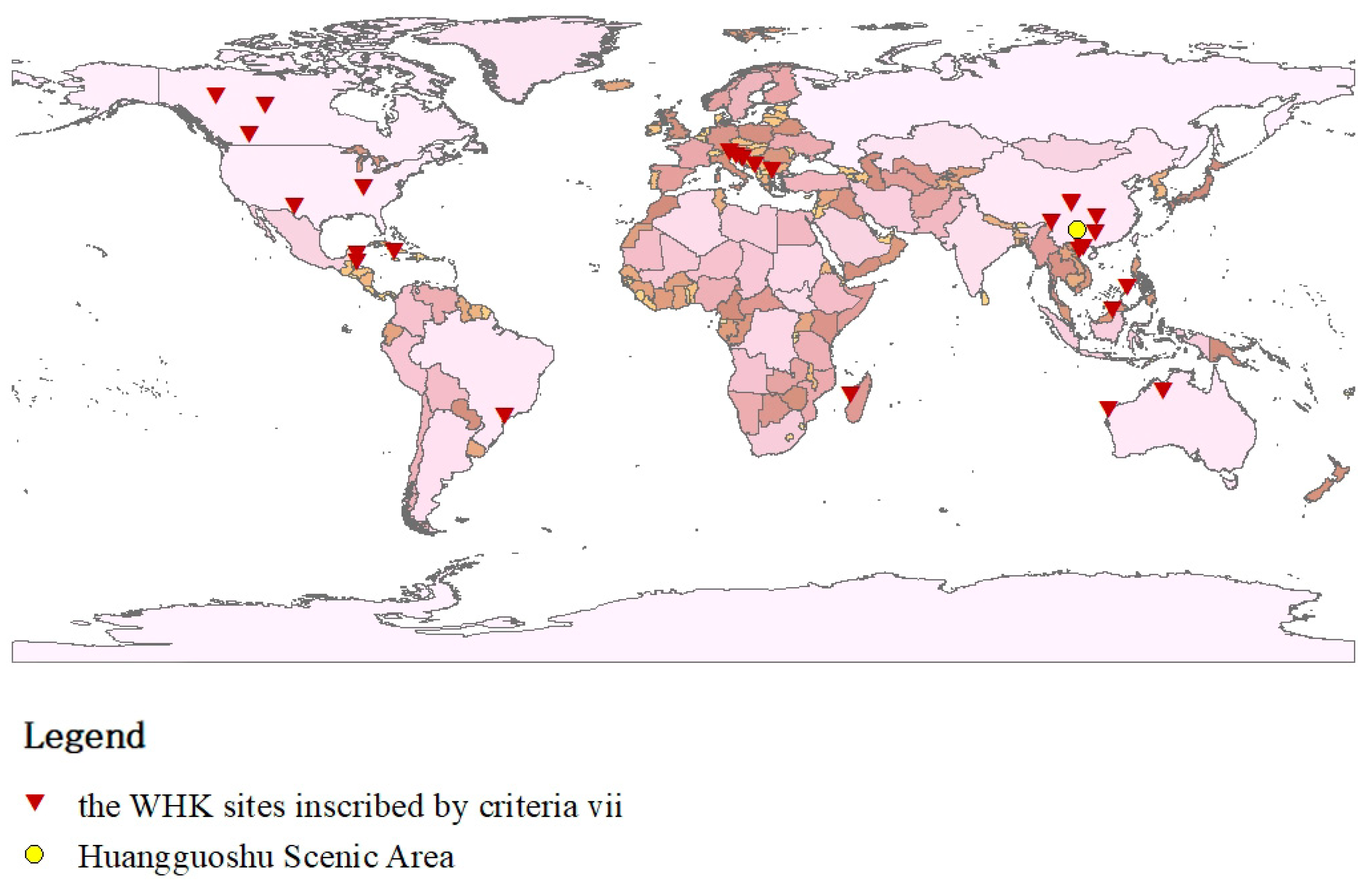
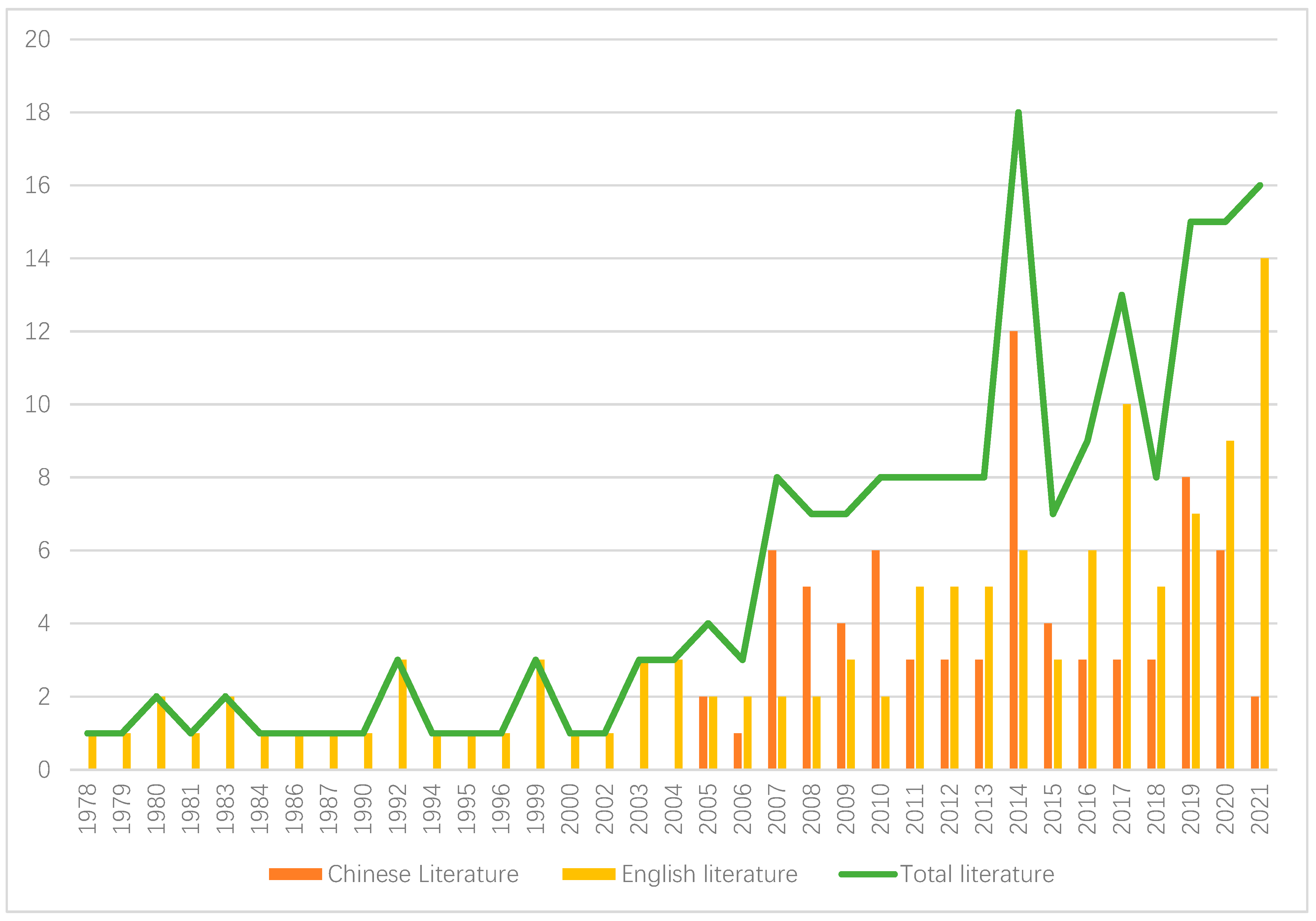
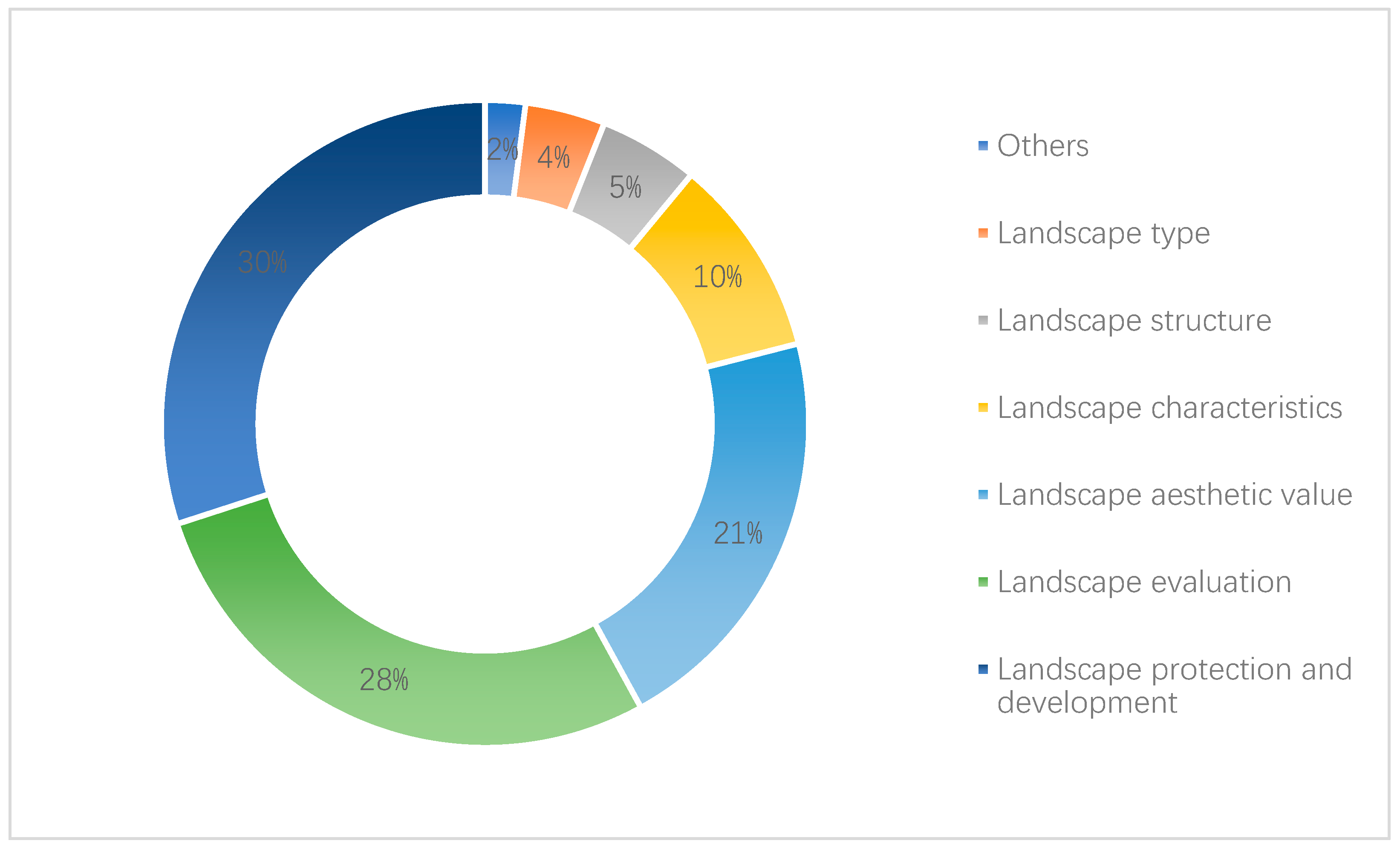
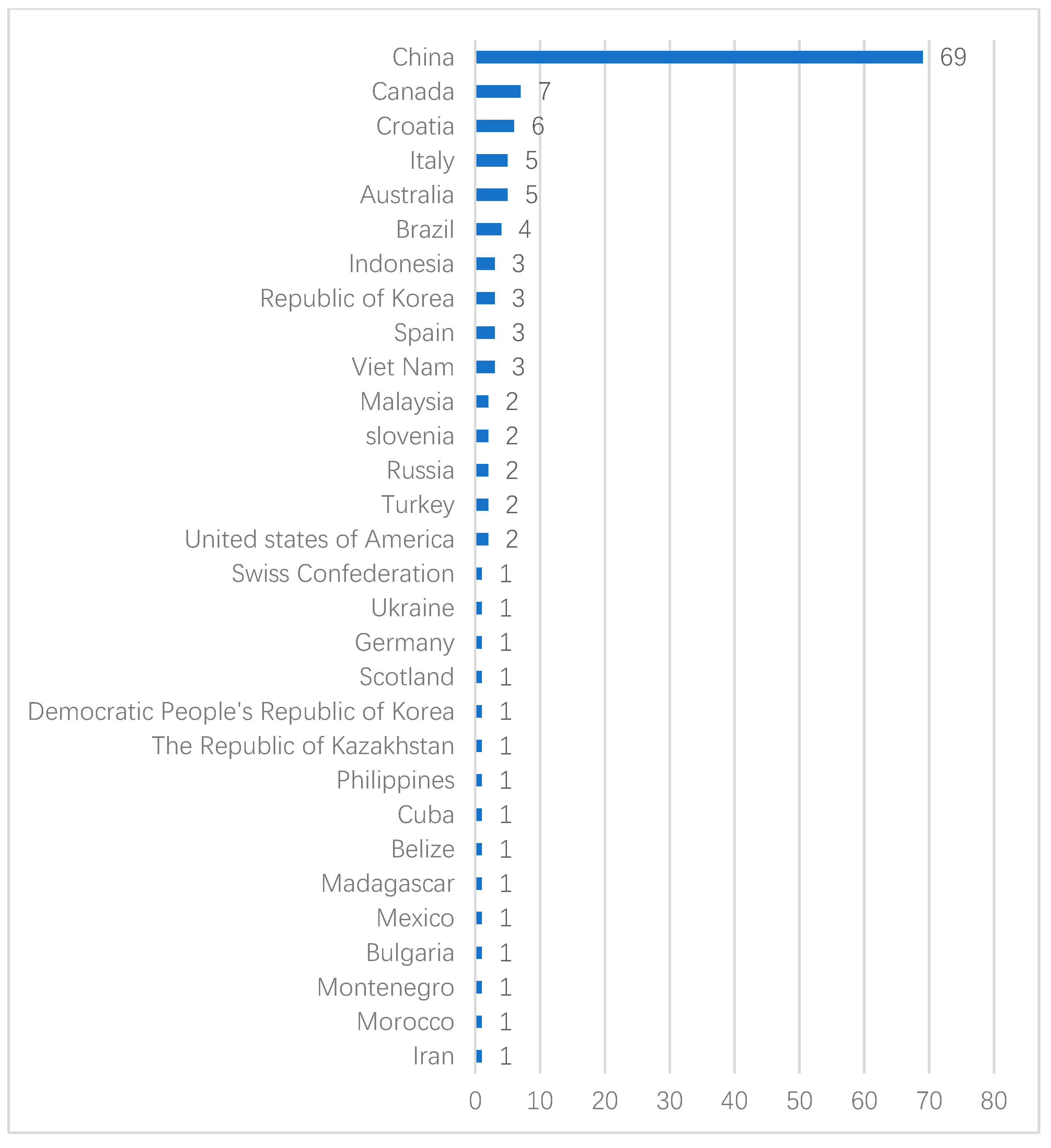
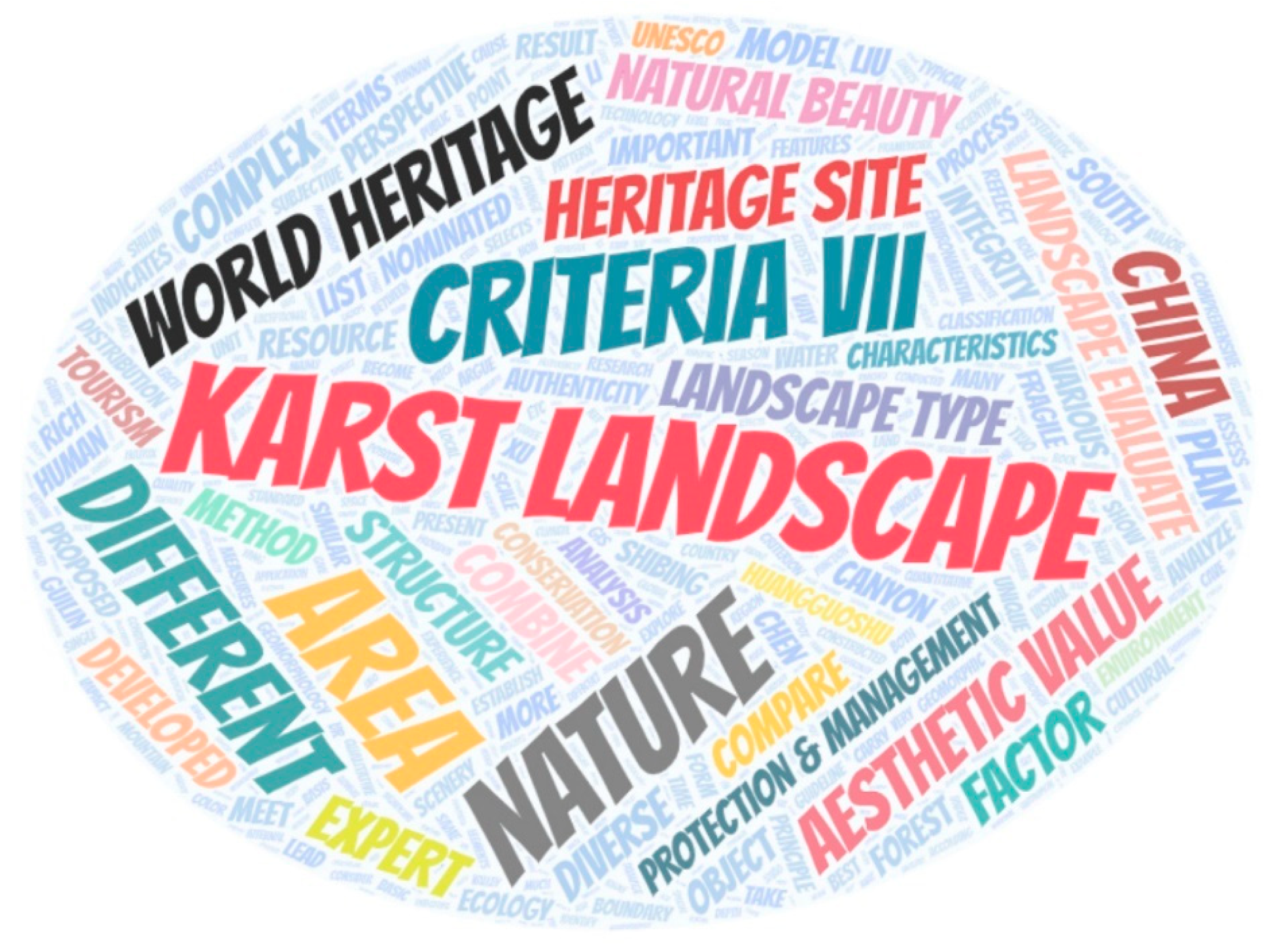
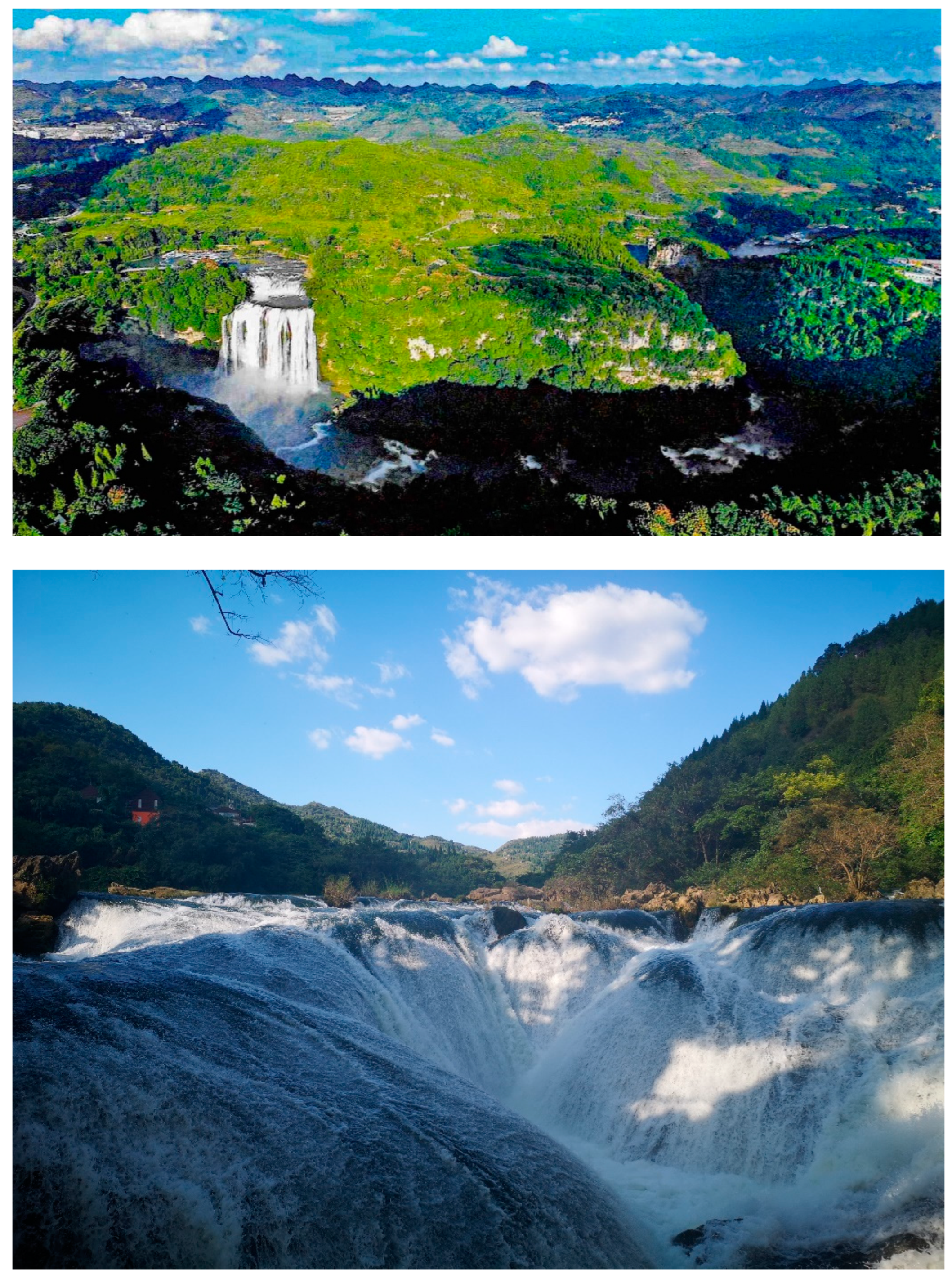
| Criteria | Contents |
|---|---|
| (i) | Represent a masterpiece of human creative genius; |
| (ii) | Exhibit an important interchange of human values, over a span of time or within a cultural area of the world, on developments in architecture or technology, monumental arts, town-planning or landscape design; |
| (iii) | Bear a unique or at least exceptional testimony to a cultural tradition or to a civilization which is living or which has disappeared; |
| (iv) | Be an outstanding example of a type of building, architectural or technological ensemble or landscape which illustrates a significant stage or significant stages in human history; |
| (v) | Be an outstanding example of a traditional human settlement, land-use, or sea-use which is representative of a culture (or cultures), or human interaction with the environment especially when it has become vulnerable under the impact of irreversible change; |
| (vi) | Be directly or tangibly associated with events or living traditions, with ideas, or with beliefs, with artistic and literary works of outstanding universal significance. (The Committee considers that this criterion should preferably be used in conjunction with other criteria); |
| (vii) | Contain superlative natural phenomena or areas of exceptional natural beauty and aesthetic importance; |
| (viii) | Be outstanding examples representing major stages of earth’s history, including the record of life, significant on-going geological processes in the development of landforms, or significant geomorphic or physiographic features; |
| (ix) | Be outstanding examples representing significant on-going ecological and biological processes in the evolution and development of terrestrial, fresh water, coastal and marine ecosystems and communities of plants and animals; |
| (x) | Contain the most important and significant natural habitats for in-situ conservation of biological diversity, including those containing threatened species of Outstanding Universal Value from the point of view of science or conservation. |
| Schools | Content | Advantages and Limitations | Applications |
|---|---|---|---|
| Expert paradigm | Aesthetic evaluation and classification, aesthetic landscape sensitivity measurement, visual impact assessment (VIA), visual absorptivity (VAC) measurement, visual resource management, etc. | The practicality of large-scale land-use planning and forest landscape resource management is outstanding, and it is easy to produce objective and comparable evaluation results. However, the evaluation scale is too coarse and the complete description of the aesthetic characteristics of the landscape is controversial | Topographical maps, photographs, computers, expert site assessments, and public surveys. |
| Psychophysical paradigm | Measure aesthetic elements from photographs, predict aesthetic preference variables and study the relationship between aesthetic landscape object elements and aesthetic values based on aesthetic features reflecting changes in grade quality (individual evaluation). Photographs are commonly used to assess, grade, compare and predict the degree of the aesthetic beauty of a landscape in relation to adjacent areas (SBE). | Attention is paid to the perceptual connection between the subject and object of landscape evaluation, acknowledging that landscapes can be evaluated quantitatively and that people are generally consistent in their aesthetics of landscapes. However, this approach over-considers objectivity, photographic evaluation lacks a sense of reality and the spatiality of the site and is mostly an immediate evaluation of the perception of the landscape, lacking cultural influences. | Photographs and PowerPoint shows are used to represent the field environment, mostly for predictive management of forests, urban green spaces, rivers, highways, and recreational landscapes. |
| Cognitive paradigm | Individual evaluation: consisting of ‘like-dislike, the tendency-avoidance, experience/emotion/evocation’ Model group evaluation: observation-shelter theory; evaluation of landscape by the ease of interpretation and solvability criteria (ease of interpretation consists of consistency and clarity, solvability consists of planar complexity and spatial mystery); evaluation of topography and landscape openness. | Emphasis is placed on immersive spatial experience, linking the subject and object of the landscape through the medium of information, and uncovering long-lived landscape preference control factors. However, it is limited to tests of human naturalness, basic survival needs, and physiological responses, and lacks sociocultural evaluation and aesthetic analysis, as well as subjective perception-objective landscape links, making its application difficult. | Photographs, topographic maps as a tool, mostly used for forest landscape assessment, and examples of computer translation of landscape information already exist. |
| Experimental paradigm | A study of artistic works by literary artists and their personal experiences of the landscape; the aesthetic history of the landscape, the meaning of the landscape and its transformation in society; the description of the landscape, the geography of the landscape, and the historical landscape. | Enriching the identifiable factors that influence the perception of the landscape, is no longer limited to the object elements of the landscape. However, the over-reliance on the artist’s individuality makes perception unpredictable, making it difficult to draw universally agreed patterns and lacking practical value for landscape planning and management. | Textual descriptive landscape evaluation and organization of garden mood sequences. |
Publisher’s Note: MDPI stays neutral with regard to jurisdictional claims in published maps and institutional affiliations. |
© 2022 by the authors. Licensee MDPI, Basel, Switzerland. This article is an open access article distributed under the terms and conditions of the Creative Commons Attribution (CC BY) license (https://creativecommons.org/licenses/by/4.0/).
Share and Cite
Wang, X.; Xiong, K.; Zhang, M.; Zhao, X. The Aesthetic Value of World Heritage Karst: A Literature Review and Implication for Huangguoshu Scenic Area Outstanding Universal Value. Sustainability 2022, 14, 15961. https://doi.org/10.3390/su142315961
Wang X, Xiong K, Zhang M, Zhao X. The Aesthetic Value of World Heritage Karst: A Literature Review and Implication for Huangguoshu Scenic Area Outstanding Universal Value. Sustainability. 2022; 14(23):15961. https://doi.org/10.3390/su142315961
Chicago/Turabian StyleWang, Xin, Kangning Xiong, Meng Zhang, and Xi Zhao. 2022. "The Aesthetic Value of World Heritage Karst: A Literature Review and Implication for Huangguoshu Scenic Area Outstanding Universal Value" Sustainability 14, no. 23: 15961. https://doi.org/10.3390/su142315961
APA StyleWang, X., Xiong, K., Zhang, M., & Zhao, X. (2022). The Aesthetic Value of World Heritage Karst: A Literature Review and Implication for Huangguoshu Scenic Area Outstanding Universal Value. Sustainability, 14(23), 15961. https://doi.org/10.3390/su142315961






